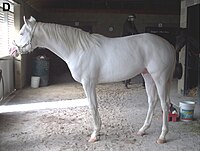
CRISPR-mediated targeting of HER2 inhibits cell proliferation through a dominant negative mutation.
Sign Up to like & getrecommendations! Published in 2017 at "Cancer letters"
DOI: 10.1016/j.canlet.2016.10.033
Abstract: With the discovery of the CRISPR/Cas9 technology, genome editing could be performed in a rapid, precise and effective manner. Its potential applications in functional interrogation of cancer-causing genes and cancer therapy have been extensively explored.… read more here.
Keywords: crispr; dominant negative; negative mutation; cancer ... See more keywords

Leukemia inhibitory factor signaling in Xenopus embryo: Insights from gain of function analysis and dominant negative mutant of the receptor.
Sign Up to like & getrecommendations! Published in 2019 at "Developmental biology"
DOI: 10.1016/j.ydbio.2018.12.020
Abstract: Leukemia inhibitory factor (LIF) is a cytokine member of the interleukin 6 family (IL6) of cytokines. It signals through a heterodimer receptor complex that consists of the LIF receptor (or LIFR formerly known as gp190)… read more here.
Keywords: dominant negative; function; lif; leukemia inhibitory ... See more keywords

Dominant-negative antagonists of the Ras-ERK pathway: DA-Raf and its related proteins generated by alternative splicing of Raf.
Sign Up to like & getrecommendations! Published in 2019 at "Experimental cell research"
DOI: 10.1016/j.yexcr.2019.111775
Abstract: The Ras-ERK pathway regulates a variety of cellular and physiological responses, including cell proliferation, differentiation, morphogenesis during animal development, and homeostasis in adults. Deregulated activation of this pathway leads to cellular transformation and tumorigenesis as… read more here.
Keywords: dominant negative; raf; ras erk; erk pathway ... See more keywords

Transcriptome analysis of dominant-negative Brd4 mutants identifies Brd4-specific target genes of small molecule inhibitor JQ1
Sign Up to like & getrecommendations! Published in 2017 at "Scientific Reports"
DOI: 10.1038/s41598-017-01943-6
Abstract: The bromodomain protein Brd4 is an epigenetic reader and plays a critical role in the development and maintenance of leukemia. Brd4 binds to acetylated histone tails and activates transcription by recruiting the positive elongation factor… read more here.
Keywords: negative brd4; dominant negative; brd4 mutants; small molecule ... See more keywords

A dominant negative variant of RAB5B disrupts maturation of surfactant protein B and surfactant protein C
Sign Up to like & getrecommendations! Published in 2022 at "Proceedings of the National Academy of Sciences of the United States of America"
DOI: 10.1073/pnas.2105228119
Abstract: Significance The Rab5 GTPase functions in early endosome (EE) fusion in the endocytic pathway. Here, we propose that RAB5B also has a noncanonical vesicular fusion function in the regulated secretion pathway that produces mature surfactant… read more here.
Keywords: variant rab5b; rab5b; surfactant protein; lung ... See more keywords

Hypomorphic and dominant-negative impact of truncated SOX9 dysregulates Hedgehog-Wnt signaling, causing campomelia.
Sign Up to like & getrecommendations! Published in 2022 at "Proceedings of the National Academy of Sciences of the United States of America"
DOI: 10.1073/pnas.2208623119
Abstract: Haploinsufficiency for SOX9, the master chondrogenesis transcription factor, can underlie campomelic dysplasia (CD), an autosomal dominant skeletal malformation syndrome, because heterozygous Sox9 null mice recapitulate the bent limb (campomelia) and some other phenotypes associated with… read more here.
Keywords: sox9; campomelia; sox9 y440x; wnt signaling ... See more keywords

Translational readthrough of GLA nonsense mutations suggests dominant-negative effects exerted by the interaction of wild-type and missense variants
Sign Up to like & getrecommendations! Published in 2019 at "RNA Biology"
DOI: 10.1080/15476286.2019.1676115
Abstract: ABSTRACT Nonsense mutations are relatively frequent in the rare X-linked lysosomal α-galactosidase A (α-Gal) deficiency (Fabry disease; FD), but have been poorly investigated. Here, we evaluated the responsiveness of a wide panel (n = 14)… read more here.
Keywords: missense variants; dominant negative; interaction wild; nonsense mutations ... See more keywords

A dominant-negative regulatory mechanism of SQSTM1 droplets-based autophagy
Sign Up to like & getrecommendations! Published in 2022 at "Autophagy"
DOI: 10.1080/15548627.2022.2029672
Abstract: ABSTRACT SQSTM1/p62 is an autophagy receptor, forming droplets to sequester intracellular polyubiquitinated cargo and mediate its delivery for autophagic clearance. SQSTM1 droplets can function as platforms to allow the formation of autophagosomes at their surfaces.… read more here.
Keywords: cleavage; sqstm1 droplets; sqstm1; dominant negative ... See more keywords

Characterisation of dominant-negative GH receptor variants reveals a potential therapeutic target for short stature.
Sign Up to like & getrecommendations! Published in 2023 at "European journal of endocrinology"
DOI: 10.1093/ejendo/lvad039
Abstract: OBJECTIVE Growth hormone insensitivity (GHI) encompasses growth restriction, normal/elevated growth hormone (GH), and low insulin-like growth factor I (IGF1). 'Non-classical' GHI is poorly characterised and is rarely caused by heterozygous dominant-negative (DN) variants located in… read more here.
Keywords: growth restriction; ghr; growth; ghr variants ... See more keywords

A dominant negative splice variant of the heparan sulfate biosynthesis enzyme NDST1 reduces heparan sulfate sulfation
Sign Up to like & getrecommendations! Published in 2022 at "Glycobiology"
DOI: 10.1093/glycob/cwac004
Abstract: Abstract NDST1 (glucosaminyl N-deacetylase/N-sulfotransferase) is a key enzyme in heparan sulfate (HS) biosynthesis, where it is responsible for HS N-deacetylation and N-sulfation. In addition to the full length human enzyme of 882 amino acids, here… read more here.
Keywords: sulfation; heparan sulfate; sulfate biosynthesis; enzyme ... See more keywords

Dominant Negative TRAF3 Variant With Recurrent Mycobacterium abscessus Infection and Bronchiectasis
Sign Up to like & getrecommendations! Published in 2022 at "Open Forum Infectious Diseases"
DOI: 10.1093/ofid/ofac379
Abstract: Abstract Host factors leading to pulmonary nontuberculous mycobacteria (PNTM) disease are poorly understood compared with disseminated NTM disease, which is linked to the interleukin 12–interferon gamma signaling pathway. We investigated the tumor necrosis factor receptor… read more here.
Keywords: traf3; infection; traf3 variant; negative traf3 ... See more keywords